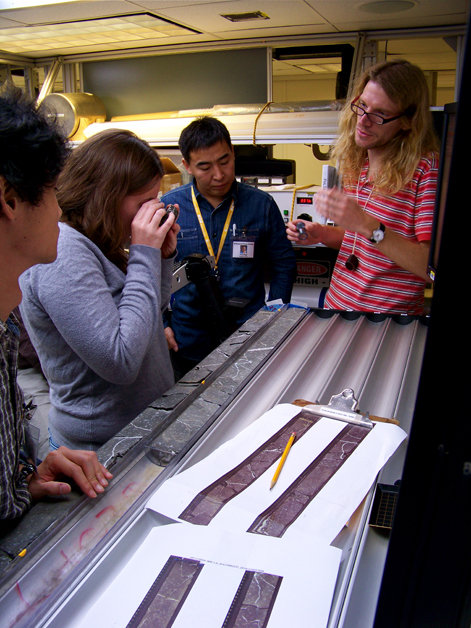
Core Describers
Hello. I’m sailing on the Louisville Expedition 330 and I’ll be blogging about what I do, the science onboard the ship and life at sea in general. This first blog will be an introduction to what I do.
I’m a volcanologist. On this expedition I am working as part of a group of core describers. The core describers are the folks who look at and study the rock-core. Once the core is on the deck, it gets run through a series of machines which measure the physical properties of the whole core. It then gets washed and cut into half so there is an ‘archive’ half for storage and a ‘working’ half which is cut up for samples both on ship and offshore when all the scientists go home.
The core describers as a whole look at the ‘archive’ half of the core. I am part of the Petrologist Core Describers and we look at the hardrock (igneous rock) that is recovered. We have to identify the rock, crystals, structures and alteration features of the core. There are three teams: the igneous petrologists like me, the structural petrologists and the alteration petrologists.
For each section of core we have to study it very carefully. We describe its colour, its texture (is it made up of small (fine) grains or large (coarse) grains), the presence of any vesicles (vesicles are little holes made by gas bubbles in the rock when it cooled), what crystals are in it and make other observations that you would on any hand sample of igneous rock. The structural team look at features such as fractures, faults and veins. The alteration team assess how altered, or how fresh, the rock is. We can also get thin sections of the rock cut. These are very thin (30 micron thick) slivers of rock that you can see through. We study these under microscopes and make more detailed observations than we can on the core. All this information gets entered into a big database, which is added to by all the other core describers. This gives the scientists on board a really good understanding of the rocks that we are drilling through and from this we can make some interpretations about what kind of rocks we’re looking at and how they were formed!
These rocks have never been sampled before. We don’t know much about the Louisville Seamount Chain. So, I’m excited to get the first core on deck and take a look!